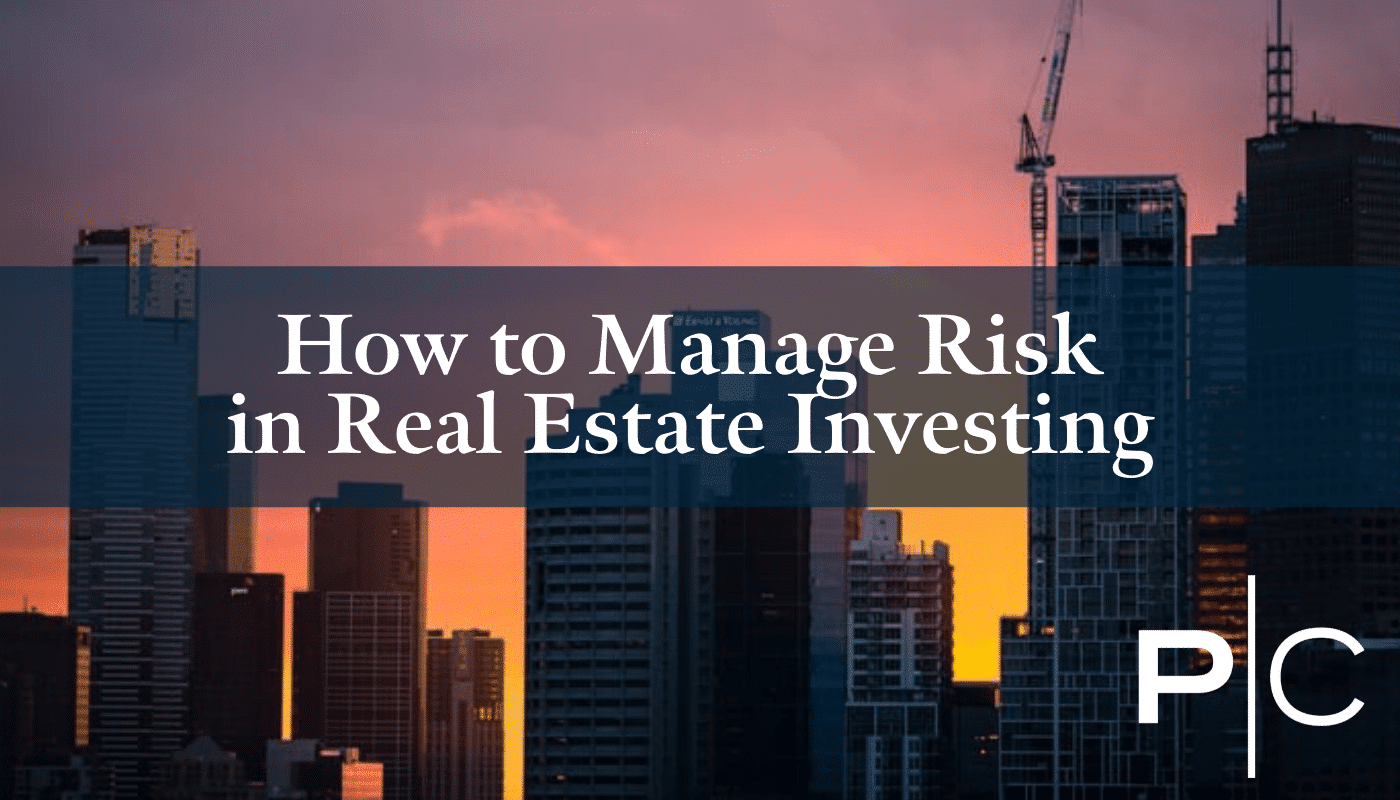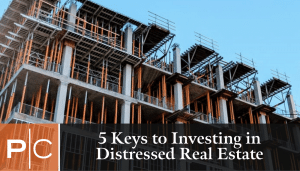How to Manage Risk in Real Estate Investing
By Ed Rogan, Owner, Co-Founder

No investment is foolproof, and that is particularly true when investing in commercial real estate. There is some level of risk associated with any real estate deal. That doesn’t mean you shouldn’t invest. On the contrary, projects with high levels of risk can generate phenomenal returns. The key is spending thorough time understanding the nuances of the deal – particularly, the risks associated with the deal and how the project sponsor plans to mitigate those risks accordingly.
First things first: always ask a private equity real estate fund manager about project risks. If the fund manager tells you there are no risks, run away! There are always risks, some of which might be completely out of control of the project sponsor. For example, the economy could plummet and construction financing could be more difficult to obtain. That’s a risk associated with any ground-up or major redevelopment project, and not one that is project-specific. An adept fund manager will have a keen understanding of both micro-level (project) and macro-level (economic) risks.
Once the risks have been identified, take some time to understand how the fund manager plans to mitigate those risks. There are a few tried-and-true ways to manage the risk associated with any real estate deal.
Underwrite Each Deal Conservatively
There’s nothing inherently wrong with high-risk real estate deals. In fact, the higher the risk, the higher the potential reward (i.e. the returns for investors). The key is to account for this risk in the initial underwriting.
Let’s say a project is anticipated to generate a 20% cash-on-cash return. These numbers can only be achieved if everything with the project goes according to plan. But in commercial real estate, things rarely go exactly according to plan. Construction costs could increase, extreme weather events can cause project delays, units may lease up more slowly than anticipated or at rents lower than expected, etc. These risks should all be factored into the developer’s pro forma.
Using one of the examples above, let’s say the developer of a 50-unit apartment building was expecting to deliver the ground-up project in 18-months with units leasing for $2,000 on average. What happens to the bottom line if the project actually takes 24-months to complete and units ultimately only lease for $1,800? Would you still feel comfortable with the projected returns?
An adept sponsor may instead underwrite the deal assuming a 24-month construction schedule with units leasing for $1,800. They’ll manage the project to meet, even exceed, those expectations. If it turns out that the project is wrapped up and delivered with a bow after 18 months and units lease up for $2,000, the cost savings and higher cash flow is just additional upside that can be returned to investors accordingly.
The key here is to underwrite conservatively from the outset. Analyze all “doomsday” scenarios and be sure you can live with those numbers in case things don’t go according to plan.
Evaluate Each Deal According to Your Investment Objectives
The risk associated with any specific real estate deal depends, at least in part, on an investor’s specific investment objectives. For example, if your goal is to invest in real estate for appreciation, some deals will inherently be riskier than others. Depending on where we are in the market cycle, some properties might not have much more room to appreciate. That doesn’t mean these properties couldn’t otherwise be strong investment opportunities. Instead, they might be better suited for a long-term, buy and hold investor who is more interested in earning passive cash flow.
Let’s use the example of an apartment building in the Houston area. A 150-unit apartment building is on the market for $30 million. This same building sold for just $22 million five years ago. It may seem absurd to pay an $8 million premium for this property today, but again, it really depends on the investor’s objectives. That price translates into $200,000 per unit, which is a steal by standards today in the Houston market. The project sponsor anticipates that a modest $5 million injection in capital will make these units worth 25% more. Given the current rental market, the sponsor anticipates generating an 5.8% return for investors.
A 5.8% return might not seem particularly noteworthy given the double-digit returns that some other projects offer. Yet if your portfolio contains several other high-risk investments, opting for a modest 5.8% return for an investment in a core market might actually be the perfect move.
Sign up to receive our educational newsletter and to gain exclusive access to our next investment opportunity.
Consider Market Cycle
Real estate tends to move in 10- to 20-year market cycles. Within any market cycle, there are four parts: expansion, contraction, recession and recovery. There are certain macro-level risks associated with each part of the market cycle. For example, unemployment might spike during a recession, making it more difficult for renters to pay a premium for new luxury apartment buildings. Conversely, interest rates might rise during a period of contraction, making it more expensive to obtain financing for your deal.
Understanding where we are in any given market cycle will help to mitigate the macro-level risks associated with commercial real estate projects. Developers can then plan for and mitigate these risks accordingly. A developer might, for example, adjust their projected cap rates (upward) if they anticipate an upcoming softening in the market. If the market doesn’t soften and instead, remains the same or improves, that’s icing on the cake that will generate even better returns for investors.
Monitor Leverage
One of the biggest mistakes real estate investors make is becoming too highly levered. Almost all commercial real estate deals will use some form of debt financing. More conservative lenders will want to see a 65%- to 75% debt-to-equity ratio on any given project. This obviously increases the amount of equity the project sponsor needs to raise in advance.
Some private equity managers will try to spread equity too thin by leveraging 90-100% debt financing. This creates substantial risk for investors (and the bank!) if and when the market softens. In the wake of a market correction, the property value could decrease. A fund paying a higher interest rate for that higher debt-to-equity ratio may then be unable to refinance into a lower rate since they have little to no equity in the deal. If the borrower is unable to make debt service payments, they are then at risk of losing the property to foreclosure. Those with lower debt-to-equity ratios have a more substantial cushion to weather economic downturns. They can simply hold the property, continue collecting rents and paying down the mortgage until the economy later improves.
Conclusion
As you can see, there are many ways to mitigate the risks associated with any commercial real estate deal. Each private equity manager will handle risk differently. During your due diligence process, be sure to probe and ask a sponsor how they plan to account for project and economic risks. Understanding how they project forward in their assumptions can be quite telling.
RELATED ARTICLES
5 Keys to Investing in Distressed Real Estate
5 Keys to Investing in Distressed Real Estate By Ed Rogan, Owner, Co-Founder Buying distressed real estate certainly isn’t for the faint of heart. An inexperienced investor can easily be swayed by the promise of a project sponsor who doesn’t actually have a plan for turning the property around. But that doesn’t mean you shouldn’t…
READ MORE >Gaining an Edge through Cold Calling
Gaining an Edge through Cold Calling By Ed Rogan, Owner, Co-Founder In many ways, commercial real estate is an “eat what you can kill” industry. The most successful investors, developers, brokers and other CRE professionals earn their living by scouring the market to uncover the next big deal. Ask the industry’s best and they’ll often…
READ MORE >Trial by Fire: How We Got Started
Trial by Fire: How We Got Started By Ed Rogan, Owner, Co-Founder People often use the term “trial by fire” to explain how they learned something. In our case, the term is all too appropriate. Looking back on it, the story of how Percy and I got started almost seems unbelievable. We were just…
READ MORE >


